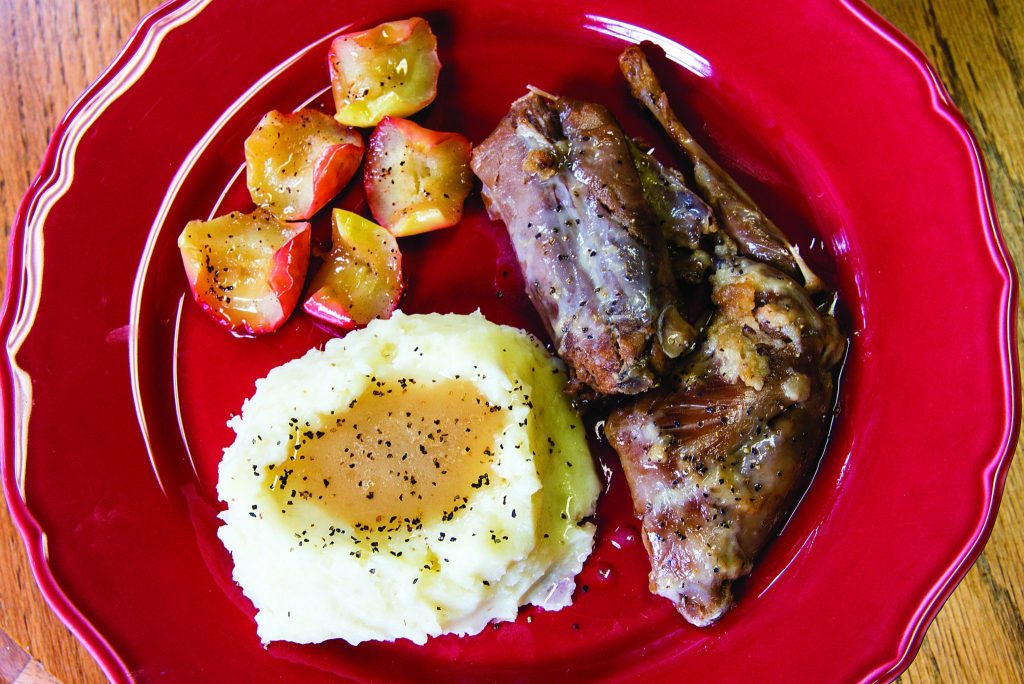
By Gerry Steinauer, Botanist
When I was growing up, once a year my family would shoot a few rabbits while hunting pheasant and quail. The following weekend, using the rabbits, Mom would undertake what she called “the task of making hasenpfeffer.” Then, my uncles and older male cousins on the Steinauer side of the family would gather at our house for an evening meal of hasenpfeffer and gravy-smothered dumplings. This was followed by endless games of five-point pitch played for a cow and a calf (a dollar a game and fifty cents a set) accompanied by drinking a few highballs and bickering and laughing well into the night.
Hasenpfeffer is a traditional German dish of brined and stewed rabbit. “Hase” is German for hare or rabbit while “pfeffer” literally translates to pepper, referring to the general spiciness of the recipe which hinges on a spicy vinegar marinade with a long soak time. A gravy is usually made from the brine, in which the rabbit is cooked, and ladled over noodles, potatoes or dumplings.
I never participated in hasenpfeffer feasts. I was so disgusted by the sour, vinegary aroma of the cooking rabbit that only near-starvation could have forced me to consume such a vile-smelling lagomorph. The other Steinauers showed no such nitpickiness and consumed it with lip-smacking vigor.
Last spring, at a gathering of the extended Steinauer family, a chat with some cousins somehow turned to, of all topics, hasenpfeffer. I was captivated as they reminisced about long-ago meals of hasenpfeffer at their own family tables. It was obvious: hasenpfeffer dinners were once a tradition in the Steinauer family and I needed to dig deeper.
I called my source for family history, my nearly 90-year-old uncle Clem Steinuaer of Tecumseh. He vividly recalled eating hasenpfeffer as a child in Pawnee County. “I loved it.” he said. “Grandma Steinauer used to send me out with orders to shoot a young cottontail or jackrabbit for hasenpfeffer. We couldn’t afford much store-bought meat back then, but rabbits were plentiful.” He may still have a copy of his grandma’s hasenpfeffer recipe “stashed somewhere.”
I also talked with my mom, Mary Ann Steinauer of Omaha. Strangely, though of full German heritage, her maiden name was Dahmke, and raised on a farm on the outskirts of Millard, she had never heard of hasenpfeffer until marrying my dad. Despite cooking hasenpfeffer at my dad’s request, she, like her squeamish youngest son, could never bring herself to eat it. “It must be an acquired taste from childhood,” she mused.
She thought the recipe she used was likely the same Steinauer recipe that Uncle Clem had stashed somewhere. My sister recently found my mom’s at- least-60-year-old handwritten copy of this recipe folded in a cookbook.
Recently, to revive a family tradition, and using two rabbits I harvested last winter, I used my great grandma’s recipe and made hasenpfeffer. Would I Iike it? Or would my tastes still be tainted from soured childhood memories?
Well … first of all, my now more sophisticated nose found the aroma of the cooking hasenpfeffer rather pleasant, slightly tangy, earthy – far from disgusting. As to the taste, it was really good. The meat was moist, fall-off-the-bone tender with just the right amount of spiciness and sourness. The gravy was wonderful over mashed potatoes.
Now I see why the Steinauer boys liked their hasenpfeffer. I never would have guessed it, but they had pretty good culinary tastes.
The Steinauer Hasenpfeffer Recipe
By Gerry Steinauer, Botanist
Ingredients:
- 1 dressed rabbit, cut into pieces
- 2 cups vinegar
- 3 cups water
- 1/2 cup sugar
- 1 sliced onion
- 2 teaspoons salt
- 1/2 teaspoon pepper
- 1 teaspoon pickling spice
- 1/4 cup far or oil (I used lard)
- 2 tablespoons of flour (I used more)
Soak the rabbit 36 to 48 hours in the pickling mixture (vinegar, water, sugar, onion, salt, pepper and pickling spice) in the refrigerator. Roll rabbit pieces in flour and sear in oil, then boil them in the same pickling mixture for 45 to 60 minutes or until tender. Remove the rabbit and thicken the mixture with flour to make gravy.
After searing, instead of boiling the rabbit, I cooked the pieces, along with three cups of the pickling mixture, in a crockpot set on high for four hours. Cooked this way, the gravy did not need thickening.
Numerous hasenpfeffer recipes using various pickling mixtures and cooking methods can be found online. Squirrel, and likely pheasant, can be substituted for rabbit in the recipes.
